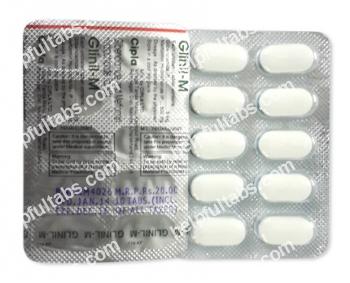There is no review for this product at the moment, but you can be the first to add or you can read more in Testimonials Page about related products.
Add Review
Your review is on premoderation.
Common Use
Glucovance is an oral medication combining two hypoglycemic drugs from different groups: metformin and glibenclamide. Metformin, a biguanide, lowers blood glucose levels by enhancing insulin sensitivity in peripheral tissues, reducing carbohydrate absorption in the gastrointestinal tract, and inhibiting glucose synthesis in the liver. Glibenclamide, a sulfonylurea derivative, stimulates insulin secretion by pancreatic β-cells. This medication is used alongside a diet and exercise program to manage type 2 diabetes (non-insulin-dependent diabetes).
Dosage and Direction
Take Glucovance twice daily with meals and a full glass of water. Consistent daily use at the same times ensures optimal benefits.
Precautions
- Avoid alcohol during treatment.
- Consult your doctor before use if you have fever, thyroid disorders, hypofunction of the anterior pituitary or adrenal cortex, severe breathing problems, thyroid disease, anemia, or vitamin B-12 deficiency.
- Inform your physician if you are pregnant, breastfeeding, or have other significant health concerns.
Contraindications
- Hypersensitivity to metformin, glyburide, or sulfonylurea derivatives.
- Type 1 diabetes, diabetic ketoacidosis, precoma, or coma.
- Kidney failure or dysfunction, severe dehydration, infection, or shock.
- Conditions causing tissue hypoxia (e.g., cardiac/respiratory failure, recent myocardial infarction).
- Hepatic impairment, porphyria, pregnancy, breastfeeding.
- Co-administration with miconazole, infectious diseases, extensive surgery, trauma, burns.
- Abnormal liver function, chronic alcoholism, acute alcohol intoxication, lactic acidosis.
- Usage 48 hours before/after iodinated contrast agents.
- Patients over 60 or doing intense physical work (increased lactic acidosis risk).
- Low glucose diet.
Side Effects
- Common side effects: swelling, rapid weight gain, nausea, vomiting, gas, bloating, diarrhea, loss of appetite.
- Seek emergency help for lactic acidosis symptoms: shortness of breath, stomach pain, weakness, drowsiness, slow heart rate, cold feeling, muscle pain, light-headedness, fainting.
- Allergic reactions: hives, swelling, rash.
Drug Interactions
- Cimetidine increases Glucovance blood levels.
- Avoid alcohol and use caution with indirect anticoagulants and cimetidine.
- Glucovance enhances furosemide metabolism.
- Sulfonylurea derivatives, insulin, acarbose, MAO inhibitors, ACE inhibitors, oxytetracycline, cyclophosphamide, and salicylates increase Glucovance effects.
- Decreased hypoglycemic effect with thyroid medications, birth control pills, hormones, epinephrine, glucagon, thiazide diuretics, nicotinic acid derivatives, and azole antifungals.
Missed Dose
Take the missed dose as soon as remembered, but skip it if it is almost time for the next dose. Do not double the dose. Resume the regular schedule the next day.
Overdose
Overdose symptoms include low blood sugar signs: hunger, tremors, confusion, irritability, drowsiness, headache, weakness, sweating, fast heartbeat, or seizures. Keep a sugar source handy and seek immediate medical help if symptoms occur.
Storage
Store at room temperature (20-25°C or 68-77°F), away from moisture, heat, and sunlight. Avoid storing in bathrooms or places accessible to children.
Disclaimer
The information provided is general and does not cover all directions, interactions, or precautions. It should not be used for self-treatment or self-diagnosis. Always consult your healthcare provider for specific instructions. We disclaim reliability for any errors or consequences resulting from the use of this information.



















 Delivery
Delivery Delivery
Delivery